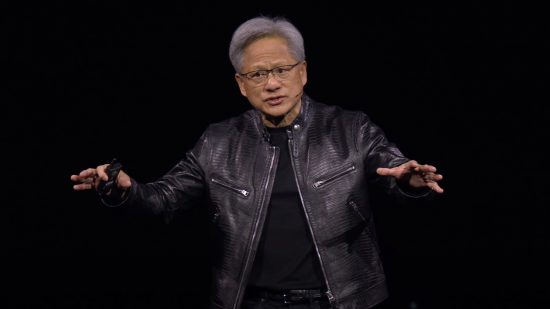Technologies powered by artificial intelligence (AI) have been used to enhance GeForce graphics cards for several years now, but its growing capabilities could soon find GPUs out of the driver’s seat in the future. This is according to Nvidia CEO, Jensen Huang, who envisions a future in which every pixel of a game is generated by AI within the next decade.
Features like Frame Generation and Deep Learning Super Sampling (DLSS) upscaling, both reliant on AI, go a long way to giving Nvidia the edge in the ongoing best graphics card tug of war against its competitors. Impressive as these technologies are, though, they require frame data generated by traditional rendering techniques as a base to work from, and can actually negatively affect frame rates if GPU performance falls short.
This bottleneck of sorts, caused by a reliance on the GPU, could become a thing of the past if Jensen Huang has anything to say about it. Fresh from demoing new Blackwell GPUs and ACE NPCs at GTC 2024, the Nvidia CEO took questions from the media following his keynote.
During the Q&A session Huang was asked: “How far do you think we are in this world where every pixel is generated at real-time frame rates? And what is your vision for gaming and non-gaming experiences in that new paradigm?”
Huang’s response was somewhat lengthy, and we’ve included it below, but for the sake of brevity we’ll zoom in on a few claims he made, specifically: “We’re probably already two years into it. And so I would say that within the next five to ten years.”
This may seem fanciful but doesn’t feel entirely impossible, particularly given how quickly DLSS upscaling and frame generation have improved. You only have to look at the power of OpenAI’s generative AI platform Sora and, to a lesser extent, ChatGPT to see how fast this sector can move.
As someone who frequently uses DLSS upscaling, I’ve already become well accustomed to games partly rendered by AI. With this in mind, the idea of my GPU becoming subservient to, or replaced by, a neural processing unit (NPU) doesn’t feel like an impossible future.
Here is the full response from Jensen Huang (via Tom’s Hardware):
“I think with almost almost everything in technology, the S curve is not longer than a decade once it becomes true, once it becomes practical and better. And, of course, ChatGPT is not only practical; in most cases, it’s better. I think it’s less than ten years away. In ten year’s time you’re at the other end of that S curve. In five years from now, you’re probably right in the middle where everything is changing in real-time, and everybody’s going, ‘Oh, look at that, this is happening.’ And so you just got to decide, are we two years into it, into that ten years? Probably, we’re probably already two years into it. And so I would say that within the next five to ten years, somewhere in between, it’s largely the case.”
For now, though, our more immediate attentions should be placed on the upcoming GeForce RTX 50 series graphics cards, especially given recent leaks hitting at potentially impressive RTX 5080 ray tracing performance.
